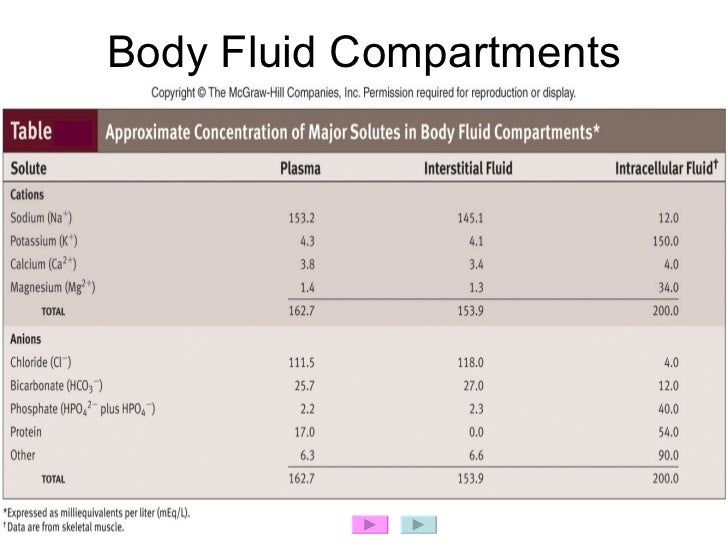
- #Water content of the body fluid compartments how to
- #Water content of the body fluid compartments series
Contractions of the heart muscle may be initiated in one of two ways. Where the flow of blood is in one direction, as is normally the case, valves in the form of flaps of tissue prevent backflow.Ī characteristic feature of hearts is that they pulsate throughout life and any prolonged cessation of heartbeat is fatal.

In the latter animals, the heart is usually a specialized, chambered, muscular pump that receives blood under low pressure and returns it under higher pressure to the circulation. This simple, tubular heart is adequate where low blood pressure and relatively slow circulation rates are sufficient to supply the animal’s metabolic requirements, but it is inadequate in larger, more active, and more demanding species. The simplest pump, or heart, may be no more than a vessel along which a wave of contraction passes to propel the blood. Blood is moved through this system by some form of pump. Fluid compartmentsīlood is circulated through vessels of the blood vascular system. In some phyla, however, the coelomic fluid has a more important role in internal distribution and is circulated by ciliary tracts. In most cases this circulation has an apparently random nature, mainly because of movements of the body and organs. Coelomic fluid itself may circulate in the body cavity.

#Water content of the body fluid compartments series
It is generally considered to have a separate identity when it is returned to the bloodstream through a series of vessels independent of the blood vessels and the coelomic space. Lymph essentially consists of blood plasma that has left the blood vessels and has passed through the tissues. The composition of blood may vary from what is little more than the environmental water containing small amounts of dissolved nutrients and gases to the highly complex tissue containing many cells of different types found in mammals. The composition of the fluid varies markedly depending on its source and is regulated more or less precisely by homeostasis.īlood and coelomic fluid are often physically separated by the blood-vessel walls where a hemocoel (a blood-containing body cavity) exists, however, blood rather than coelomic fluid occupies the cavity. In all cases the major constituent is water derived from the environment. The intracellular component includes the body cells and, where present, the blood cells, while the extracellular component includes the tissue fluid, coelomic fluid, and blood plasma. The fluid compartments of animals consist of intracellular and extracellular components. SpaceNext50 Britannica presents SpaceNext50, From the race to the Moon to space stewardship, we explore a wide range of subjects that feed our curiosity about space!.Learn about the major environmental problems facing our planet and what can be done about them! Saving Earth Britannica Presents Earth’s To-Do List for the 21st Century.100 Women Britannica celebrates the centennial of the Nineteenth Amendment, highlighting suffragists and history-making politicians.
#Water content of the body fluid compartments how to

#WTFact Videos In #WTFact Britannica shares some of the most bizarre facts we can find.

Demystified Videos In Demystified, Britannica has all the answers to your burning questions.Britannica Classics Check out these retro videos from Encyclopedia Britannica’s archives.Britannica Explains In these videos, Britannica explains a variety of topics and answers frequently asked questions.


 0 kommentar(er)
0 kommentar(er)
